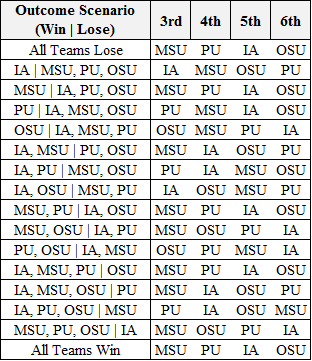The Big Ten Third and Fourth Place Race Cheat Sheet
Posted by Alex Moscoso (@AlexPMoscoso) on March 6th, 2015Last week, I broke down the race for the top four seeds in the Big Ten because finishing in that group guarantees those teams a double-bye in the upcoming Big Ten Tournament. Heading into the final weekend of the regular season, we have a much clearer picture of this race. Wisconsin and Maryland have already locked up the #1 and #2 seeds, but the #3 and #4 seeds are still very much up in the air. Currently, there is a four-way tie for third place between Iowa, Michigan State, Ohio State, and Purdue. All teams have a record of 11-6 with one game remaining — none of which are against each other. This means that there are 16 possible (and very confusing) combinations of outcomes from this weekend’s games. To help clear things up, I created a cheat sheet showing where each team will be seeded given each scenario. The table below displays the 16 possibilities: Michigan State gets a double-by in 12 of the 16 options; Purdue in nine; Iowa in six; and, Ohio State in five.
Below is a synopsis for each team:
- Michigan State. Thanks to a 3-0 record against the other three teams, the Spartans would win all of the tiebreakers and end up with a top four seed in 12 of the sixteen scenarios and with the #3 seed in nine of the 16 scenarios. It breaks down like this: If the Spartans beat Indiana on the road, they’ll lock up the #3 seed; if they lose, they’ll need at least two other teams to also fall to get the double-bye. In this four-team race, Michigan State clearly has the upper hand.
- Iowa. The Hawkeyes finish with a top four seed in six of the 16 possible scenarios. In head-to-head tiebreakers, they will have the advantage over Ohio State (2-0) but not against the other two teams (0-1). In situations where multiple teams are tied, Iowa is hurt by its two losses to Wisconsin because the others only have one loss from the Badgers.
- Purdue. The Boilermakers finish with a top four seed in nine of the 16 possible scenarios. They’re helped by a 2-2 record against the other teams and own the head-to-head tiebreaker over Iowa. But Purdue has more on the line in this weekend’s game than just good positioning in the Big Ten Tournament. They desperately need a win on Saturday against Illinois just to assure themselves an at-large NCAA Tournament bid.
- Ohio State. The Buckeyes appear to be in the most difficult spot of these teams, finishing as a top four seed in only five scenarios. They’re hurt by the fact that they have the worst head-to-head record against the group (1-3), and in fact, they finish as low as the #6 seed in seven of the 16 scenarios. To make matters even more difficult, Ohio State’s remaining game is against Wisconsin. It’s safe to say that the Buckeyes are up against it in terms of the double-bye goal.














































If multiple teams tie and have the same record within the tied teams, it’s the winning % against the top team that matters, so 0-1 is the same as 0-2.
Here is the link to tiebreakers for the Big Ten http://www.bigten.org/sports/m-baskbl/spec-rel/100606aae.html
Under multiple tied teams (look at the very end)
2. If the remaining teams are still tied, then each tied team’s record shall be compared to the team occupying the highest position in the final regular-season standings, continuing down through the standings until one team gains an advantage.
•A. When arriving at another pair of tied teams while comparing records, use each team’s record against the collective tied teams as a group (prior to their own tie-breaking procedures), rather than the performance against the individual tied teams.
•B. When comparing records against a single team or a group of teams, the higher winning percentage shall prevail, even if the number of games played against the team or group are unequal (i.e., 2-0 is better than 3-1); in the case of tied percentages vs. the team or group of 1.000 or .000 the following shall apply: 2-0 is better than 1-0; 0-1 is better than 0-2.
Here is the website for tiebreakers http://www.bigten.org/sports/m-baskbl/spec-rel/100606aae.html
Accoding to ties under multiple teams, in the second tie breaker it states “When comparing records against a single team or a group of teams, the higher winning percentage shall prevail, even if the number of games played against the team or group are unequal (i.e., 2-0 is better than 3-1); in the case of tied percentages vs. the team or group of 1.000 or .000 the following shall apply: 2-0 is better than 1-0; 0-1 is better than 0-2.”
My mistake. I’d missed or forgotten that last statement. Thanks!